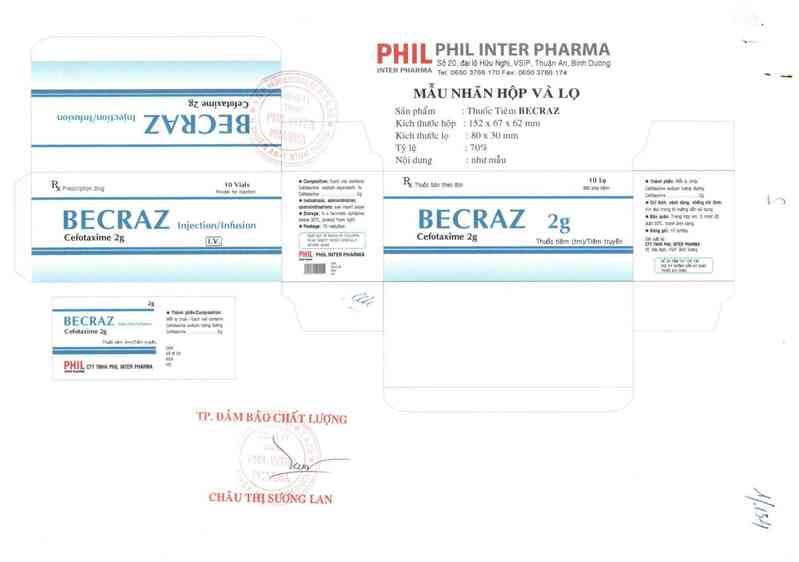
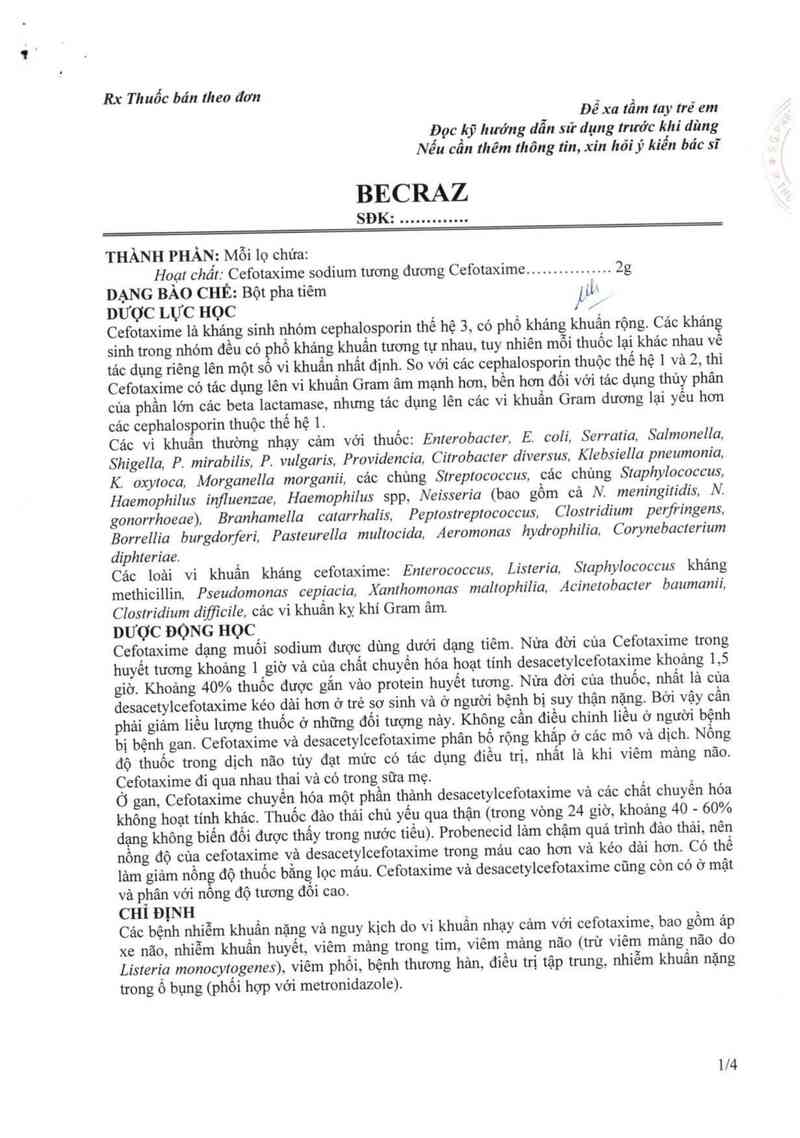
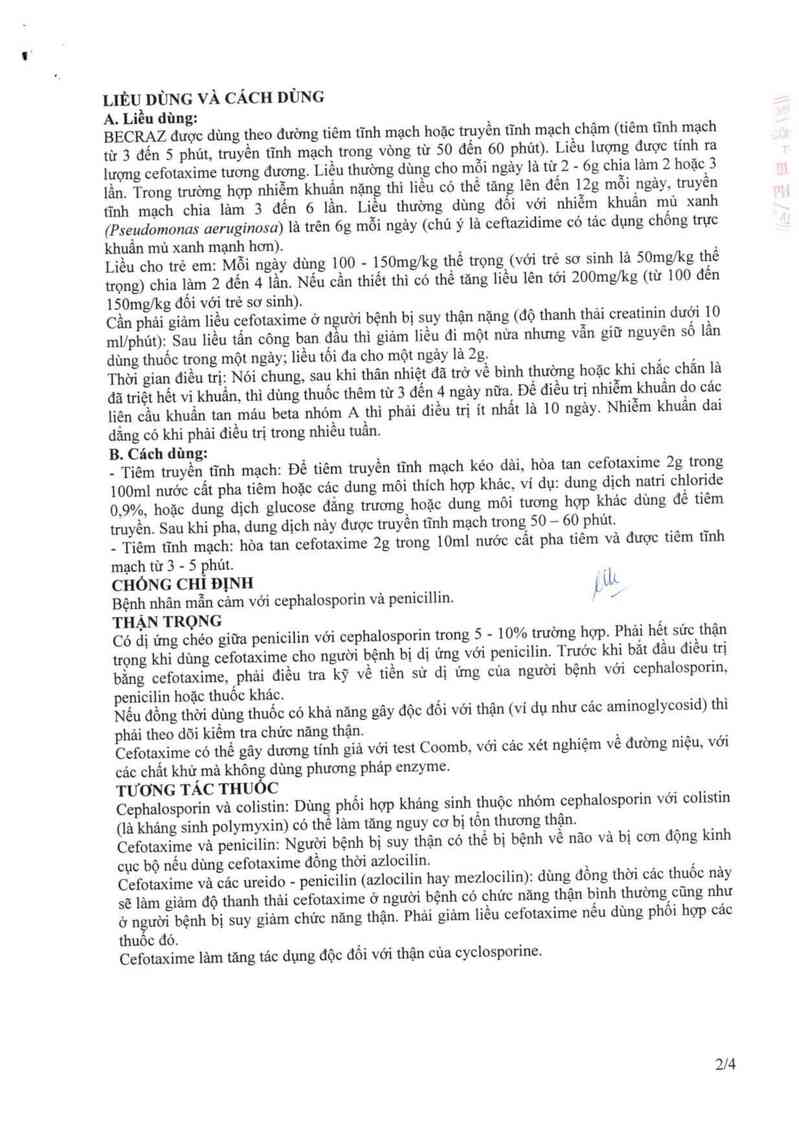
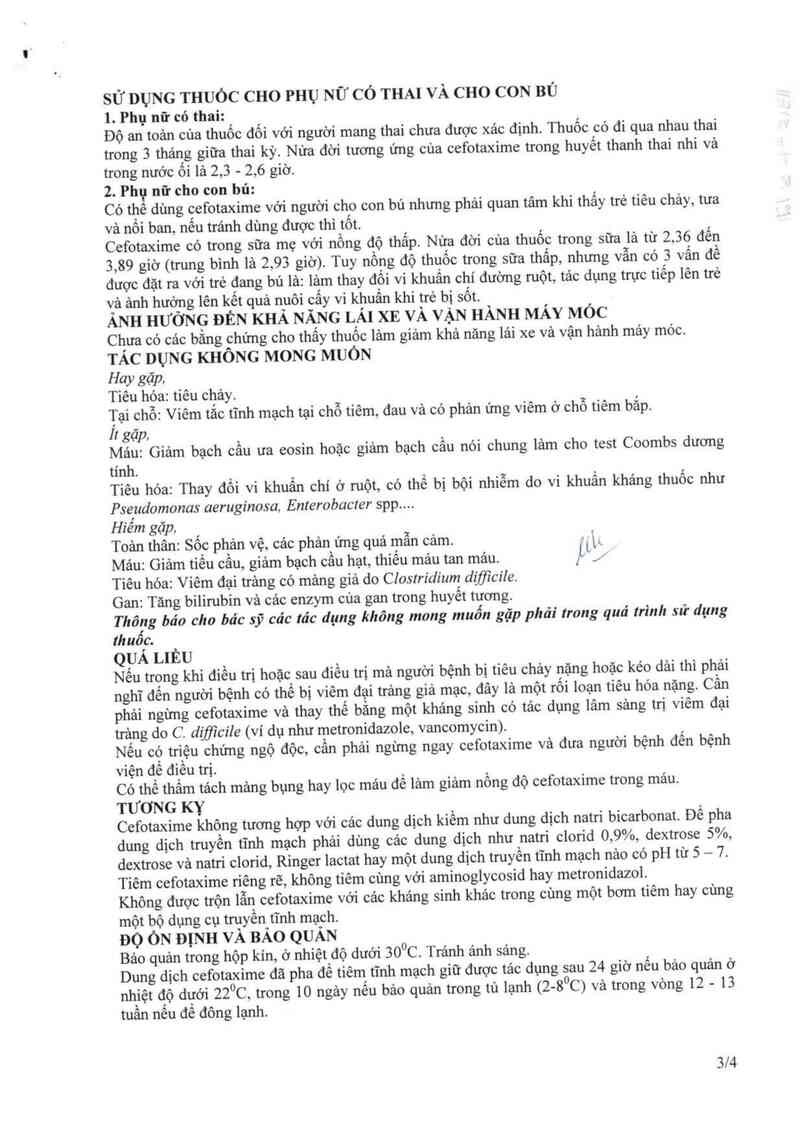
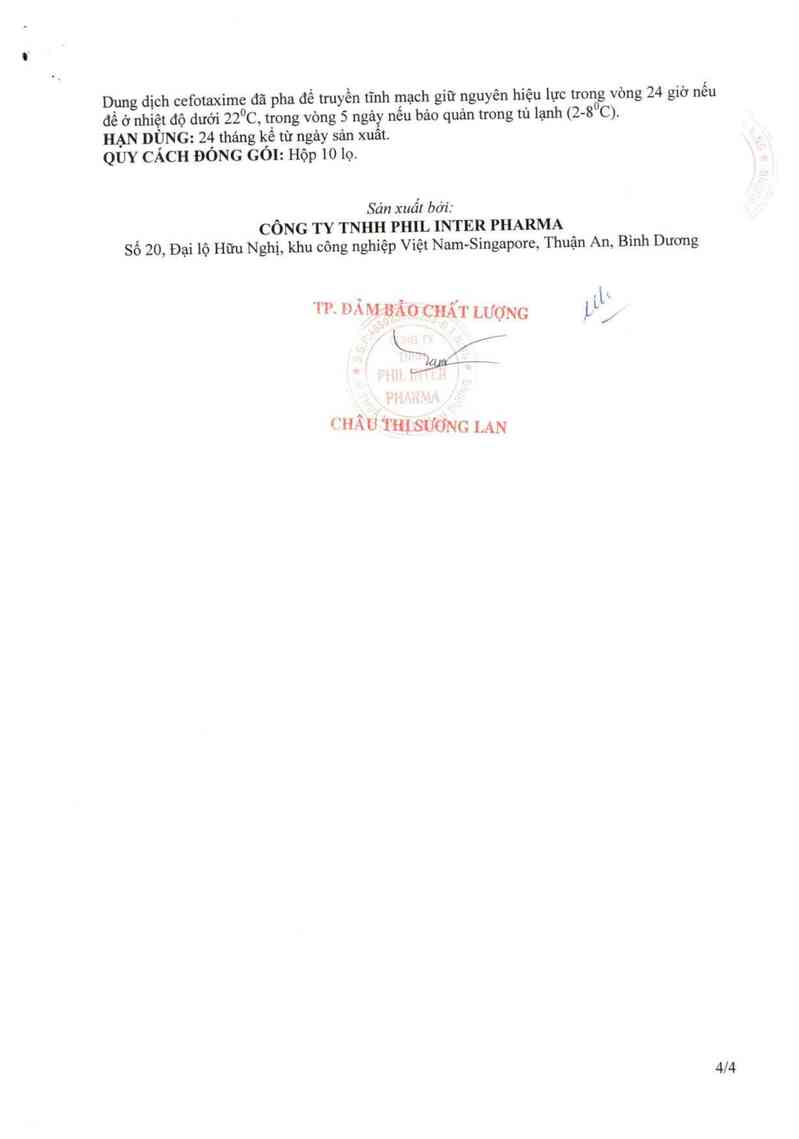
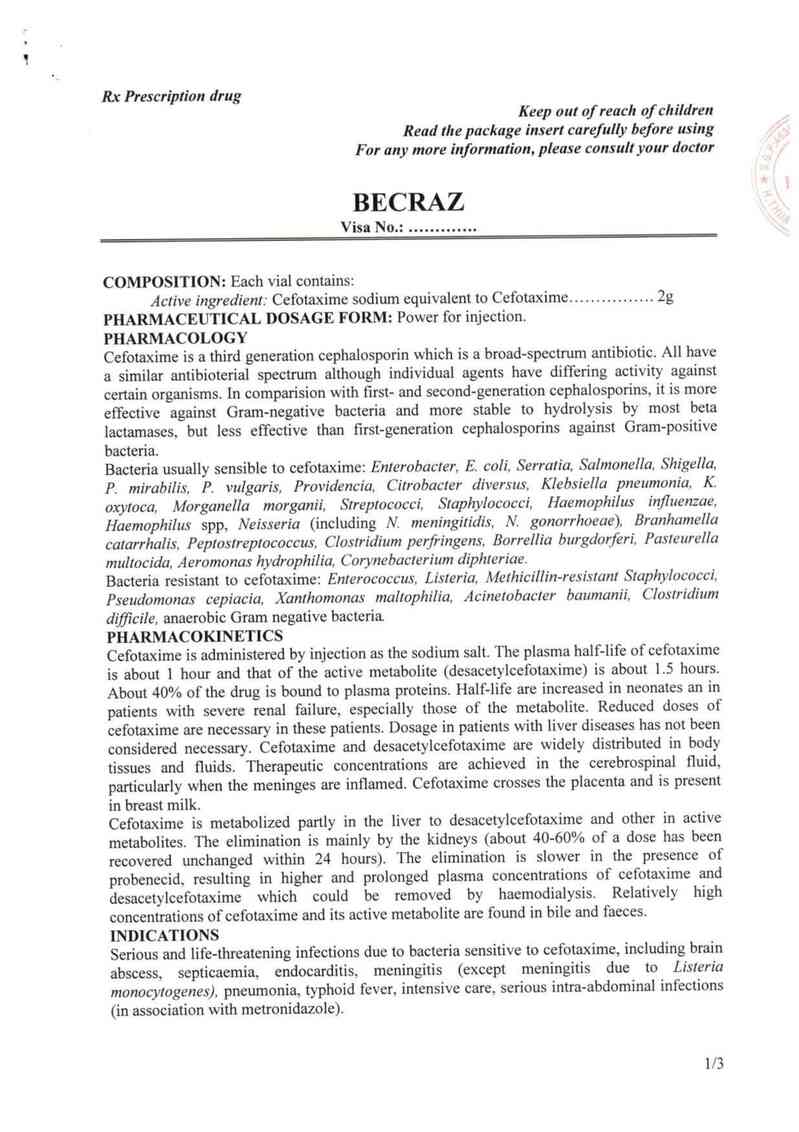
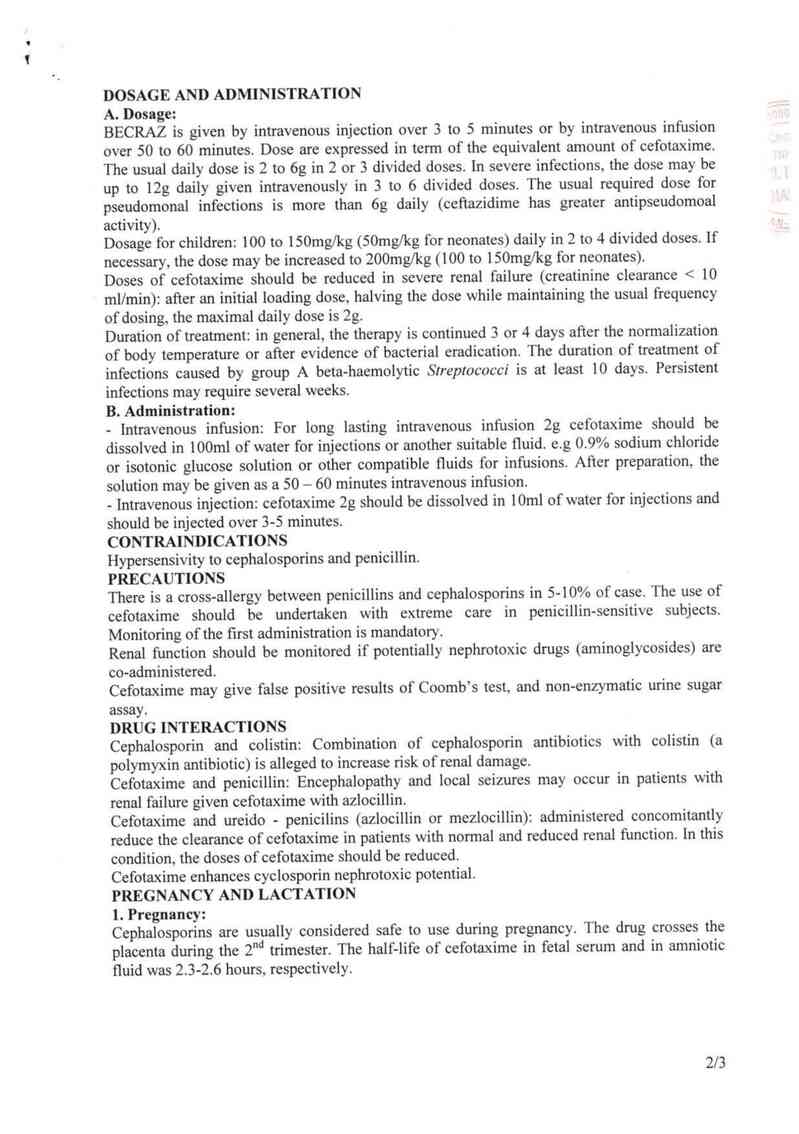
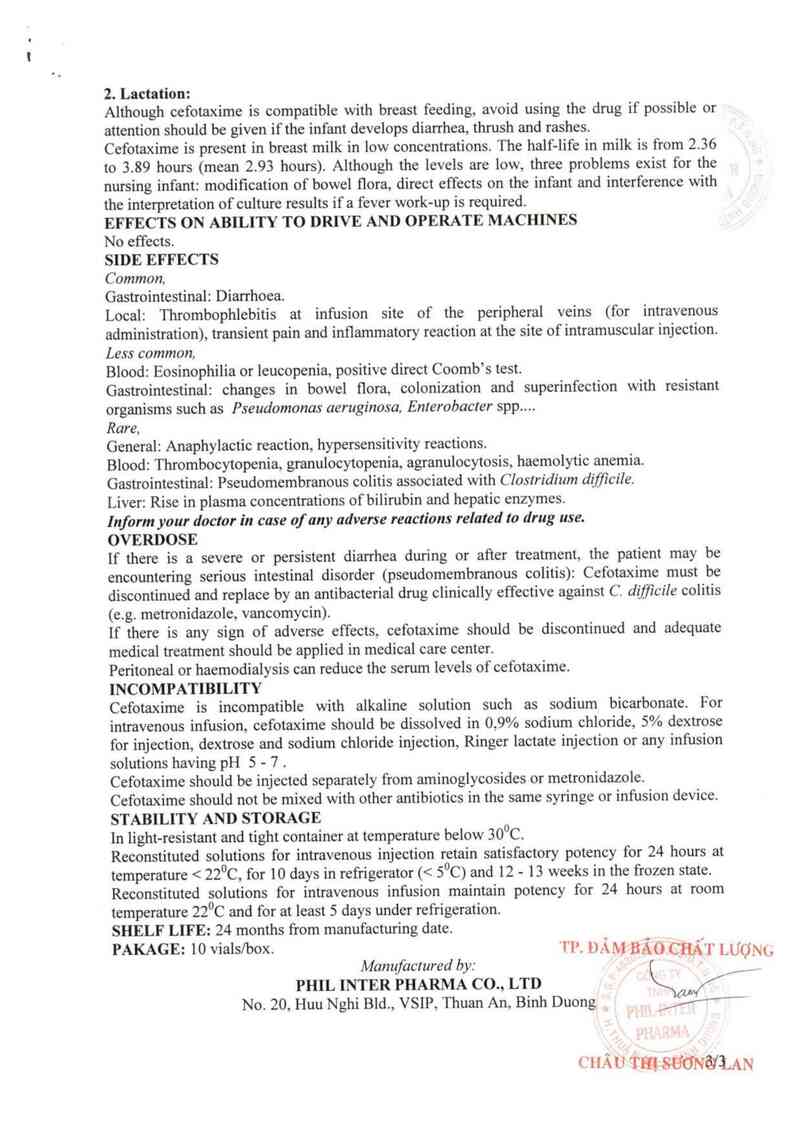
PH|LPHIL INTER PHARMA
sô zo. đai » Hữu Nghị vsnp. Thuận An Blnh Dương
-… z WTỂR PHARM^ Tel 0650 avse 110 Fax 0650 3766 174
—… MẨU NHAN HỌP VA LỌ
8z aunxuogag ~ _.f’ ’ _ .-
UOIS u luongajuu Vi . _. San phẩm 1 ThUỐC T1em BECRAZ
'nH ' ' ZVềlJẵũí ' * Kỉchthướchộp :152x67x62mm
Ề'l'_ịỀx ' { Kích thước lọ : 80 x 30 mm
— J ;, _ — . Tỷ lệ : 70%
² .’V ’) r .
> l ' NỘI dung : như mẫu
² to Lo .…- …
E\ Proscnonon uruo Mảfấfflẵm Ủ'z'w'ửmẳẫ'ẵjẩ Ri Thuơc bán moc om … … … aạw \\ưỀig
. m…. .
BECRAZ …………- BECRAZ 2 ………
Iniection/Infusion om… m… g znuazcdmưm
W\ .
Cefotaxime ²8 "_ ỂẵềuỂgwnunua Cefotaxime 2g Thuốc Mm \…)QO Wyen Ề'ổi'mmmm
zo…mvsưpnm
Hill. nanmm _
\ RurỉuvgvÉtn
.lmu ễu ỉiể_tễề lửwn
2g ' Qệ
o … '
BECRAZ ...… …. gg;ỵggỵỵ
Cefotaxlmo 2g …… lg
mú: mm \thlm \Mn …
___ị … M … nm … :Ễx
TP. ĐẢM BẮD CHẾT LƯỢNG
CHÂU TẸỂÌỈM'I’ " c LAN
WÍ/
Rx Thuốc bán theo đơn
Để xa tầm tay trẻ em
Đọc kỹ hướng dẫn sữ dụng trước khi dùng
Nếu cần Ihêm thông tin, xín hỏi ý kiến bác sĩ
SĐK: .............
THÀNH PHÀN_z Mỗi \ọ chứa:
Hqạt chât:gCefotaxime sodium tương đương Cefotaxime ................ 2g
DẠNG BAO CHE: Bột pha tiêm )jx
nược LỰC nọc } /
Cefotaxime lả khảng sinh nhóm cephalosporin thế hệ 3, có phố khảng khuấn rộng. Các khảng
sinh trong nhóm đều có phô khảng khưấn tương tự nhau, tuy nhiên mỗi thuốc lại khảo nhau vê
tảc dụng riêng lên một sô vi khuân nhât định. So với các cephalosporin thuộc thê hệ 1 và 2, thì
Cefotaxime có tảc dụng lên vi khuẩn Gram âm mạnh hơn, bền hơn đối vởi tảc dụng thùy phân
cùa phần lớn cảc beta lactamase, nhưng tảc dụng lên cảc vi khuẩn Gram dương lại yểu hơn
cảc ccphalosporin thuộc thế hệ 1. _
Cảc vỉ khuân thường nhạy cảm với thuôc: Enterobacter. E. coli. Serratia. Salmonella.
Shigella, P. mirabilis, P. vulgaris, Providencia, Citrobacter diversus, Klebsiella pneumonia,
K. oxytoca. Morganella morganii. cảc chủng Streptococcus, cảc chùng Staphylococcus,
Haemophilus injluenzae, Haemophilus spp, Neisseria (bao gồm cả N. meningỉtidis. N.
gonorrhoeae), Branhamella ca!arrhalis, Peptostreptococcus, Clostridium perfringens,
Borrellia burgdorferi, Pasteurella multocida, Aeromonas hydrophilia. Corynebacterium
diphteriae.
Cảc loải vỉ khuấn khảng cefotaxime: Enterococcus, Listeria. Staphylococcus khảng
methicillin. Pseudomonas cepiacía, Xanthomonas maltophilỉa. Acinetobacter baumanii,
Clostridium difflcỉle. cảc vi khuẩn kỵ khí Gram âm.
DƯỢC ĐỘNG HỌC
Cefotaxime dạng muối sodium được dùng dưới dạng tiêm. Nửa đời cùa Cefotaxime trong
huyết tương khoảng 1 giờ và cùa chất chuyền hóa hoạt tính desacetylcefotaxime khoảng 1,5
giờ. Khoảng 40% thuốc được gắn vảo protein huyết tương. Nửa đời cùa thuốc, nhất là cùa
desacetylcefotaxime kéo dải hơn ở trẻ sơ sinh và ở người bệnh bị suy thận nặng. Bời vậy cần
phải giảm liều lượng thuốc ở những đối tượng nảy. Không cần điều chỉnh liều ở người bệnh
bị bệnh gan. Cefotaxime vả desacetylcefotaxime phân bố rộng khắp ờ cảc mô và dịch. Nồng
độ thuốc trong dịch não tủy đạt mức có tảc dụng điều trị, nhất là khi viêm mảng não.
Cefotaxime đi qua nhau thai và có trong sữa mẹ.
Ở gan, Cefotaxime chuyến hóa một phần thảnh desacetylcefotaxime vả cảc chất chuyển hóa
không hoạt tính khác. Thuốc đảo thải chủ yếu qua thận (trong vòng 24 giờ, khoảng 40 - 60%
dạng không biến đổi được thấy trong nước tiếu). Probenecid lảm chậm quá trình đảo thải, nên
nồng độ của cefotaxime vả desacetylcefotaxime trong mảu cao hơn và kéo dâi hơn. Có thể
lảm giảm nồng độ thuốc bằng lọc mảu. Cefotaxime vả desacetylcefotaxime cũng còn có ở mật
và phân với nồng độ tương đối cao.
cnỉ ĐỊNH
Cảc bệnh nhiễm khuấn nặng và nguy kịch do vi khuẩn nhạy cảm với cefotaxime, bao gồm ảp
xe não, nhiễm khuẩn huyết, viêm mảng trong tim, viêm mảng não (trừ viêm mảng não do
Listeria monocytogenes). viêm phối. bệnh thương hản, điều trị tập trung, nhiễm khuấn nặng
trong ổ bụng (phối hợp với metronidazole).
1/4
LIÊU DÙNG VÀ CÁCH DÙNG
A. Liều dùng:
BECRAZ được dùng theo đường tiêm tĩnh mạch hoặc truyền tĩnh mạch chậm (tiêm tĩnh mạch
từ 3 đến 5 phút, truyền tĩnh mạch trong vòng từ 50 đến 60 phút). Liều lượng được tính ra
iượng cefotaxime tương đương. Liều thường dùng cho mỗi ngảy là từ 2 - 6g chia lảm 2 hoặc 3
lân. Trong trường hợp nhiễm khuấn nặng thì liều có thể tăng lên đến 12g mỗi ngảy, truyền
tĩnh mạch chia lảm 3 đến 6 lần. Liều thường dùng đối với nhiễm khuẩn mù xanh
(Pseudomonas aeruginosa) là trên 6g mỗi ngảy (chủ ý là ceftazidime có tảc dụng chống trực
khưần mù xanh mạnh hơn).
Liêu cho trẻ em: Mỗi ngảy dùng \00 - lSOmg/kg thể trọng (với trẻ sơ sinh là SOmg/kg thể
trọng) chia lảm 2 đến 4 lần. Nếu cần thiết thì có thể tăng liều lên tới 200mg/kg (từ \00 đến
lSOmg/kg đối với trẻ sơ sinh).
Cần phải giảm liều ccfotaxime ở người bệnh bị suy thận nặng (độ thanh thải creatinin dưới 10
ml/phút): Sau liêu tân công ban đâu thì giảm liều đi một nửa nhưng vẫn giữ nguyên số lần
dùng thuốc trong một ngảy; liếu tối đa cho một ngảy lả 2g.
Thời gian điều trị: Nói chung, sau khi thân nhiệt đã trở về bình thường hoặc khi chắc chắn lá
đã triệt hết vi khuấn, thì dùng thuốc thêm từ 3 đến 4 ngảy nữa. Để điều trị nhiễm khuấn do cảc
liên cầu khuấn tan mảu beta nhóm A thì phải điều trị ít nhất là 10 ngảy. Nhiễm khuấn dai
dẳng có khi phải điều trị trong nhiều tuần.
B. Cách dùng:
- Tiêm truyền tĩnh mạch: Đế tiêm truyền tĩnh mạch kéo dải, hòa tan cefotaxime 2g trong
100m1 nước cất pha tiêm hoặc cảc dung môi thích hợp khảc, ví dụ: dung dịch natri chloride
0,9%, hoặc dung dịch glucose đắng trương hoặc dung môi tương hợp khác dùng để tiêm
truyền. Sau khi pha, dung dịch nảy được truyền tĩnh mạch trong 50 — 60 phủt.
- Tiêm tĩnh mạch: hòa tan cefotaxime 2g trong lOml nước cất pha tiêm và được tiêm tĩnh
mạch từ 3 — 5 phủt.
CHỐNG cui ĐỊNH \).
Bệnh nhân mẫn cảm với cephalosporin vả penicillin. } ,
THẬN TRỌNG
Có dị ửng chéo giữa penicilỉn với cephalosporin trong 5 — 10% trường hợp. Phải hết sức thận
trọng khi dùng cefotaxime cho người bệnh bị dị ứng vởi penicilỉn. Trước khi bắt đầu điều trị
bằng cefotaxime, phải diển tra kỹ về tiền sử dị ứng cùa người bệnh với cephalosporin,
penicilỉn hoặc thuốc khảc.
Nếu đồng thời dùng thuốc có khả năng gây độc đối với thận (ví dụ như các aminogiycosid) thì
phải theo dõi kiểm tra chức năng thận.
Cefotaxime có thể gây dương tính giả vởi test Coomb, với cảc xẻt nghiệm về đường niệu, vởi
các chất khử mã không dùng phương phảp enzyme.
TƯỢNG TÁC THUỐC
Cephalosporin vả colistin: Dùng phối hợp khảng sinh thuộc nhóm cephalosporin với colistin
(iả khảng sinh polymyxin) có thề lảm tăng nguy cơ bị tốn thương thận.
Cefotaxime vả penicilỉn: Người bệnh bị suy thận có thể bị bệnh về não và bị cơn động kinh
cục bộ nếu dùng cefotaxime dồng thời azlocilin.
Cefotaxime và các ureido - penicilỉn (aziocilìn hay mezlocilin): dùng đồng thời cảc thuốc nảy
sẽ lảm giảm độ thanh thải cefotaxime ở người bệnh có chức năng thận bình thường_cũng như
ở người bệnh bị suy giảm chức năng thận. Phải giảm liều cefotaxime nếu dùng phôi hợp các
thuôc đó.
Cefotaxime lảm tăng tác dụng độc đối với thận cùa cyclosporine.
2/4
SỬ DỤNG THUỐC CHO PHỤ NỮ cỏ THAI VÀ CHO CON BÚ
1. Phụ nữ có thai:
Độ an toản của thuốc đối với người mang thai chưa được xảc định. Thuốc có đi qua nhau thai
trong 3 tháng giữa thai kỳ. Nửa đời tương ứng cùa cefotaxime trong huyết thanh thai nhi và
trong nước ối là 2,3 - 2,6 giờ.
2. Phụ nữ cho con bủ: _
Có thê dùng cefotaxime với người cho con bú nhưng phải quan tâm khi thây trẻ tiêu chảy, tưa
và nối ban, nếu tránh dùng được thì tốt.
Cefotaxime có trong sữa mẹ vởi nổng độ thẫp. Nửa đời của thuốc trong sữa là từ 2,36 đến
3,89 giờ (trung bình là 2,93 giờ). Tuy nồng độ thuốc trong sữa thấp, nhưng vẫn có 3 vấn đề
được đặt ra với trẻ đang bú lả: lảm thay đổi vi khuẩn chỉ đường ruột, tác dụng trực tiếp lên trẻ
và ảnh hưởng lên kết quả nuôi cấy vi khuấn khi trẻ bị sốt.
ÀNH HƯỚNG ĐÊN KHẢ NĂNG LẢI XE VÀ VẶN HÀNH MÁY MÓC
Chưa có cảc bằng chứng cho thấy thuốc lảm giảm khả năng lái xe và vận hảnh mảy móc.
TÁC DỤNG KHÔNG MONG MUÔN
Hay gặp.
Tiêu hóa: tiêu chảy.
'Ịại chỗ: Viêm tắc tĩnh mạch tại chỗ tiêm, đau và có phản ứng viêm ở chỗ tiêm bắp.
It gặp…
Mảu: Giảm bạch cầu ưa eosin hoặc giảm bạch cầu nói chung lảm cho test Coombs dương
tính.
Tiêu hóa: Thay đổi vì khuấn chí ở ruột, có thế bị bội nhiễm do vi khuần khảng thuốc như
Pseudomonas aeruginosa, Enterobacter spp....
Hiếm gặp.
Toản thân: Sốc phản vệ, các phản ứng quả mẫn cảm. iL'\ị
Máu: Giảm tiêu cầu, giâm bạch cầu hạt, thiêu mảu tan mảu. } /
Tiêu hóa: Viêm đại trảng có mảng giá do Clostridium difflcile.
Gan: Tăng bilirubin vả cảc enzym của gan trong huyết tương.
Thông báo cho bác sỹ các tác dụng không mong muốn gặp phải trong quá trình sử dụng
thuốc.
QUÁ LIÊU
Nếu trong khi điều trị hoặc sau điều trị mà người bệnh bị tiêu chảy nặng hoặc kéo dải thì phải
nghĩ đến người bệnh có thế bị viêm đại trảng giả mạc, đây là một rối loạn tiêu hóa nặng. Cần
phải ngừng cefotaxime và thay thế bằng một kháng sinh có tảo dụng lâm sảng trị vìêm đại
trảng do C. difflcile (ví dụ như metronidazole, vancomycin).
Nếu có triệu chứng ngộ độc, cần phải ngừng ngay cefotaxime vả dưa người bệnh đến bệnh
viện để điều trị.
Có thể thẩm tảch mảng bụng hay iọc mảu đế lảm giảm nồng dộ cefotaxime trong mảu.
TƯỚNG KY
Cefotaxime không tương hợp với cảc dung dịch kiềm như dung dịch natri bicarbonat. Đế pha
dung dịch truyền tĩnh mạch phải dùng cảc dung dịch như natri clorid 0,9%, dextrose 5%,
dextrose và natri clorid, Ringer lactat hay một dung dịch truyền tĩnh mạch nảo có pH từ 5 — 7.
Tiêm cefotaxime riêng rẽ, không tiêm cùng với aminoglycosid hay metronidazol.
Không được trộn lẫn ccfotaxime với các khảng sinh khác trong cùng một bơm tiêm hay cùng
một bộ dụng cụ truyền tĩnh mạch.
ĐỘ ÓN ĐỊNH VÀ BẢO QUẢN
Bảo quản trong hộp kín, ở nhiệt độ dưới 30°C. Trảnh ánh sảng.
Dung dịch cefotaxime đã pha để tiêm tĩnh mạch giữ được tảc dụng sau 24 giờ nếu bảo quản ở
nhiệt độ dưới 220C, trong 10 ngảy nếu bảo quản trong tủ lạnh (2-80C) vả trong vòng 12 - 13
tuần nếu để dông lạnh.
3/4
Dung dịch cefotaxime đã pha để truyền tĩnh mạch giữ nguyên hiệu lực trong vòng 24 giờ nếu
để ở nhiệt độ dưới 220C, trong vòng 5 ngảy nếu bảo quản trong tủ lạnh (2-80C).
HẠN DÙNG: 24 tháng kể từ ngảy sản xuất.
QUY CÁCH ĐÓNG GÓI: Hộp … lọ.
. Sản xuất bởi:
. CONG TY TNHH PHIL INTER PHARMA
Sô 20, Đại lộ Hữu Nghị, khu công nghiệp Việt Nam-Singapore, Thuận An, Bình Dương
11’. l›ỉ\ ồj | A’ Ll \
BỀHAT LƯỢNG \ /
.Ja'ft’
cnẨ \\ THỊ sươzvc LAN
4/4
Rx Prescription drug
Keep out of reach of children
Read the package insert carefully before using
F or any more information, please consult your doctor
BECRAZ
Visa No.: .............
COMPOSITION: Each vial contains:
Active ingredient: Cefotaxime sodium equivalent to Cefotaxime ................ 2g
PHARMACEUTICAL DOSAGE FORM: Power for injection.
PHARMACOLOGY
Cefotaximc is a third generation cephalosporin which is a broad-spectrum antibiotic. All have
a similar antibioteriai spectrum although individual agents have differing activity against
certain organisms. In comparision with first- and second-gcneration cephalosporins, it is more
effective against Gram—negative bacteria and more stable to hydrolysis by most beta
lactamases, but less effective than first-generation cephalosporins against Gram-positive
bacteria.
Bacteria usually sensible to cefotaxime: Enterobacter, E. coli, Serratia, Salmonella. Shigella,
P. mirabilis, P. vulgaris, Providencia, Citrobacter diversus, Klebsiella pneumonia. K.
oxytoca, Morganella morganii, Streptococci. Staphylococci, Haemophilus injluenzae,
Haemophilus spp, Neisseria (including N. meningilidis, N. gonorrhoeae), Branhamella
catarrhalis, Peplostreplococcus, Clostridium perfringens. Borrellia burgdorferi, Pasteurella
multocida, Aeromonas hydrophilia. Corynebacterium diphteriae.
Bacteria resistant to cefotaximc: Enterococcus, Listeria. Melhicillin-resislant Siaphylococci.
Pseudomonas cepiacia, Xanthomonas maltophilia, Acinelobacter baumanii, Clostridium
difflcile, anaerobic Gram negative bacteria
PHARMACOKINETICS
Cefotaxime is administered by injection as the sodium salt. The plasma half-life of cefotaxime
is about ! hour and that of the active metabolite (desacetyicefotaxime) is about 1.5 hours.
About 40% of the drug is bound to plasma proteins. Half-lifc are increased in neonates an in
patients with severe renal failure, especially those of the metabolite. Reduced doses of
cefotaxime are necessary in these patients. Dosage in patients with liver diseases has not been
considered necessary. Cefotaxime and desacetylcefotaxime are widely distributed in body
tissues and fluids. Therapeutic concentrations are achieved in the cerebrospinal fluid,
pax1icularly when the meninges are inflamed. Cefotaxime crosscs the placenta and is present
in breast milk.
Cefotaxime is metabolized partly in the liver to desacetylcefotaxime and other in active
metabolites. The elimination is mainly by the kidneys (about 40-60% of a dose has been
recovered unchanged within 24 hours). The elimination is slower in the presence of
probenecid, resulting in higher and prolongcd plasma concentrations of cefotaxime and
desacetylcefotaxime which could be removed by haemodialysis. Relatively high
concentrations of cefotaxime and its active metabolite are found in bilc and faeces.
INDICATIONS
Serious and life-threatening infections due to bacteria sensitive to cefotaxime, including brain
abscess, septicaemia, endocarditis, meningitis (except meningitis due to Listeria
monocytogenes), pneumonia, typhoid fever, intensive care, serious intra-abdominal infections
(in association with metronidazole).
1/3
DOSAGE AND ADMINISTRATION
A. Dosage:
BECRAZ is given by intravenous injection over 3 to 5 minutes or by intravenous infusion
over 50 to 60 minutes. Dose are expressed in term of the equivalent amount of cefotaxime.
The usual daily dose is 2 to 6g in 2 or 3 divided doses. In severe infections, the dose may be
up to 12g daily given intravenously in 3 to 6 divided doses. The usual required dose for
pseudomonal infections is more than 6g daily (ceftazidime has greater antipseudomoal
activity).
Dosage for children: 100 to lSOmg/kg (SOmg/kg for neonates) daily in 2 to 4 divided doses. If
nccessary, the dose may be increased to 200mglkg (100 to lSOmg/kg for neonates).
Doses of cefotaxime should be reduced in severe renal failure (creatinine clearance < 10
ml/min): after an initial loading dose, halving the dose while maintaining the usual frequency
of dosing, the maximal daily dose is 2g.
Duration of treatment: in general, the therapy is continued 3 or 4 days after the normalization
of body temperature or after evidence of bacterial eradication. The duration of treatment of
infections caused by group A beta—haemolytic Streptococci is at least 10 days. Persistent
infections may require several weeks.
B. Administration:
- Intravenous infusion: For long lasting intravenous infusion 2g cefotaxime should be
dissolved in ]OOml of water for injections or another suitable t1uid. e.g 0.9% sodium chloride
or isotonic glucose solution or other compatible fluids for infusions. After preparation, the
solution may be given as a 50 — 60 minutes intravenous infusion.
- Intravenous injection: cefotaxime 2g should be dissolved in lOml of water for injections and
should be injected over 3-5 minutes.
CONTRAINDICATIONS
Hyperscnsivity to cephalosporins and penicillin.
PRECAUTIONS
There is a cross-allergy between penicillins and cephalosporins in 5-10% of case. The use of
cefotaxime should be undertaken with extreme care in penicillin—sensitive subjects.
Monitoring of the first administration is mandatory.
Renal function should be monitored if potentially nephrotoxic drugs (aminoglycosides) are
co-administered.
Cefotaxime may give false positive results of Coomb’s test, and non-enzymatic urine sugar
assay.
DRUG INTERACTIONS
Cephalosporin and colistin: Combination of cephalosporin antibiotics with colistin (a
polymyxin antibiotic) is alleged to increase risk of renal damage.
Cefotaxime and penicillin: Encephalopathy and local seizures may occur in patients with
renal failure given cefotaxime with azlocillin.
Cefotaxime and ureido - penicilins (azlocillin or mezlociliin): administered concomitantly
reduce the clearance of cefotaxime in patients with normal and reduced renal function. In this
condition, the doses of cefotaxime should be reduced.
Cefotaxime enhances cyclosporin nephrotoxic potential.
PREGNANCY AND LACTATION
!. Pregnancy:
Cephalosporins are usually considered safe to use during pregnancy. The drug crosses the
placenta during the 2nd trimester. The half-life of cefotaxime in fetal serum and in amniotic
fluid was 2.3—2.6 hours, respectively.
2/3
2. Lactatiou:
Although cefotaxime is compatible with breast feeding, avoid using the drug if possible or
attention should be given if the infant develops diarrhea, thrush and rashes.
Cefotaxime is present in breast milk in low concentrations. The half-life in milk is from 2.36
to 3.89 hours (mean 2.93 hours). Although the levels are low, three problems exist for the
nursing infant: modification of bowel flora, direct effects on the infant and interference with
the interpretation of culture results if a fever work-up is required.
EFFECTS ON ABILITY TO DRIVE AND OPERATE MACHINES
No effects.
SIDE EFFECTS
Common,
Gastrointestinal: Diarrhoea.
Local: Thrombophlebitis at infusion site of the peripheral veins (for intravenous
administration), transient pain and inflammatory reaction at the site of intramuscular injection.
Less common,
Blood: Eosinophilia or leucopenia, positive direct Coomb’s test.
Gastrointestinal: changes in bowel fiora, colonization and superinfection with resistant
organisms such as Pseudomonas aeruginosa, Enterobacter spp....
Rare,
General: Anaphylactic reaction, hypersensitivity reactions.
Blood: Thrombocytopenia, granulocytopenia, agranulocytosis, haemolytic anemia.
Gastrointestinal: Pseudomembranous colitis associated with C Ioslridium dị_ffìcile.
Liver: Rise in plasma concentrations of bilirubin and hepatic enzymes.
Inform your doctor in case of an y adverse reactions related to drug use.
OVERDOSE
If there is a severe or persistcnt diarrhea during or after treatment, the patient may be
encountering serious intestinal disorder (pseudomembranous colitis): Cefotaxime must be
discontinued and replace by an antibacterial drug clinically effective against C. difficile colitis
(e.g. metronidazole, vancomycin).
If there is any sign of adverse effects, cefotaxime should be discontinued and adequate
medical treatment should be applied in medical care center.
Peritoneal or haemodialysis can reduce the serum levels of cefotaxime.
INCOMPATIBILITY
Cefotaxime is incompatible with alkaline solution such as sodium bicarbonate. For
intravenous infusion, cefotaxime should be dissolved in 0,9% sodium chloride, 5% dextrose
for injection, dextrose and sodium chloride injection, Ringer lactate injection or any infusion
solutions having pH 5 — 7 .
Cefotaxime should be injected separater from aminoglycosides or metronidazole.
Cefotaxime should not be mixcd with other antibiotics in the same syringe or infusion device.
STABILITY AND STORAGE
In light—resistant and tight container at temperature below 300C.
Reconstituted solutions for intravenous injection retain satisfactory potency for 24 hours at
temperature < 220C, for 10 days in refrigerator (< 50C) and 12 - 13 weeks in the frozen state.
Reconstituted solutions for intravenous infusion maintain potency for 24 hours at room
temperature 220C and for at least 5 days under refrigeration.
SHELF LIFE: 24 months from manufacturing date.
PAKAGE: 10 vials/box. TP, \)Ẩ M BÃO CHẤT LƯỢNb
Manufac!ured by: _
PHIL INTER PHARMA CO., LTD ktwợ/Ớ
No. 20, Huu Nghi Bld., VSIP, Thuan An, Bỉnh Duong /”
i`HÂ U 'rm sươnêilm
+ "Lưu ý những sản phẩm đăng trên website thuộc loại thực phẩm chức năng: những sản phẩm này không phải là thuốc và không có tác dụng thay thế thuốc chữa bệnh"
+ Dùng thuốc theo chỉ định của Bác sĩ
+ Đọc kỹ hướng dẫn sử dụng trước khi dùng